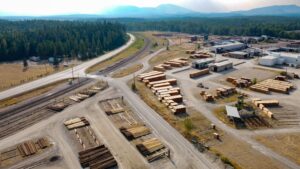 Did you know that up to 80% of the environmental damage that a product causes is determined in the design phase? Taking a look at a few LCA examples can help find where these problems arise before a single product is produced.
Did you know that up to 80% of the environmental damage that a product causes is determined in the design phase? Taking a look at a few LCA examples can help find where these problems arise before a single product is produced.
Life Cycle Assessment (LCA) gives insights into hidden costs, helping sustainability teams, supply chain managers, and others to make better decisions, and reduce carbon footprints and other environmental issues.
By looking at life cycle assessment examples, we can gain strategies for incorporating these analyses into decision-making. There are lessons to be learned for every team that can help you measurably reduce your environmental footprint and increase transparency.
LCA Explained: Key Concepts and Methodology
A Life Cycle Assessment (LCA) allows companies to evaluate the environmental impacts of a product or service across all life cycle stages- from design and raw material extraction to eventual disposal or recycling.
Following standards like ISO 14040, LCAs provide a framework that allows businesses to understand their operation’s environmental effects. Armed with this knowledge of carbon footprint and material and energy flows, decision-makers are better able to draw conclusions and make choices that balance between environmental impacts and operational efficiency.
LCA In Action: Real-World Examples at a Glance
Taking this methodology and applying it to a few real-world examples from different industrial areas lets us see how environmental analysis can help companies meet their regulatory duties as well as offer a boost in consumer trust.
LCA Examples in Sustainable Product Design
LCA Examples in Supply Chain Management
LCA Examples in Construction
Advanced LCA Examples
LCA Examples for Regulatory Compliance
LCA in Sustainable Product Design: How LCA Drives Eco-Friendly Choices

Making clever choices during the initial phases of manufacturing, focusing on sustainable product design, can dramatically reduce a product’s environmental impact.
Everyone from product designers to engineers and architects can harness LCA to make better-informed decisions, reducing the final product’s impact in areas like greenhouse gas emissions.
For example, an LCA was conducted to compare different building materials for eco-friendly office buildings. Using LCA software, the architects were able to examine the life cycle of traditional concrete, recycled steel, and cross-laminated timber (CLT). They found that CLT offered roughly 25-30% less embodied carbon than concrete and recycled steel offered around 10-15%. This insight guided the architect to select CLT, aligning their design with their sustainability goals.
Supply Chain Efficiency: Reducing Scope 3 Emissions with LCA
Up to 90% of an organization’s total environmental impact comes from Scope 3 emissions– the indirect emissions throughout the supply chain. Conducting an LCA allows your team to find and map the hotspots along the chain and develop strategies to reduce them.
Likewise, a leading electronics manufacturer harnessed LCA to scrutinize the thousands of components and supplier processes in their supply chain. This revealed that some suppliers’ manufacturing processes significantly elevated their emissions. They took this data to their suppliers and collaborated to help them move towards renewable energy sources and improve their manufacturing efficiency.
The final result of this collaboration? A 25% reduction in Scope 3 Emissions over two years.
Through precise mapping and strategic intervention, managing the carbon emissions from your supply chain becomes much easier. It also offers companies to get ahead of the regulatory curve, exceed stakeholder expectations for transparency, and push forward with their net-zero commitments.
Sustainable Construction: LCA for Building Performance and Material Choices
LCAs can be used to great effect in the construction industry, dramatically boosting environmental credentials. An analysis of the impacts can help guide sustainable material choices and ensure that buildings perform in the long-term too.
Developers frequently use LCA software like Ecochain to evaluate design choices, allowing them to weigh up the energy efficiency of the final product against its immediate environmental impact.
For example, during the design stage of an urban residential complex, developers used LCA to compare three different glazing options and two HVAC configurations. This allowed them to pinpoint the most efficient combination.
The chosen glazing reduced heating and cooling demands by roughly 25%, while the HVAC system cut energy consumption by an additional 15%, resulting in lower carbon emissions across the building’s lifespan and lower utility bills for the residents.
LCA Examples: Taking Your Sustainability Analysis to the Next Level
LCA solutions can help organizations forecast their environmental impacts and model the results of changes they’re considering.
Scenario analysis is a powerful tool that allows sustainability teams to evaluate how environmental outcomes may vary under different conditions.
Uncertainty modeling is another feature of LCA software. This allows teams to deal with data gaps and variability in LCA studies. By quantifying the uncertainties around data quality, emission factors, and modeling assumptions, they can provide context for interpreting LCA results.
Other advanced features of LCA software like Ecochain help data collection on mid and endpoint indicators. These differentiate between immediate impacts like carbon emissions from manufacturing and long-term impacts on human health across a product life cycle.
LCA Examples: Demonstrating Sustainability and Building Trust With Stakeholders
Perhaps the most pressing issue that businesses look to products like Ecochain to deal with is meeting regulations around environmental impacts. Structures like ISO 14001, ISO 14040 and the GHG Protocol require accurate, detailed reports.
LCA software allows companies to meet these rigorous standards and produce the EPDs that their products need.
Take the example of a global flooring manufacturer who quantified the environmental impact of their products, following ISO 14040 guidelines. This allowed them to spot hotspots long their production chain and take steps to reduce them. The process also provided the detailed data they needed for their ISO 14001 certification, demonstrating their commitment to product sustainability to external auditors and stakeholders alike.
The Future of Sustainability: Powered by LCA
Taking these real-world examples, it’s clear to see the power that LCA software brings to companies conscious of their environmental duties. They allow everyone from designers to supply chain managers to make informed choices, based on quantitative data, balancing impact with efficiency while ensuring compliance with international regulations around environmental burdens.
Harnessing these insights is key to thriving in an ever more environmentally conscious marketplace.
FAQs on LCA Examples
What is an example of a Life Cycle Assessment (LCA)?
A: A practical example of a Life Cycle Assessment (LCA) is architects comparing the sustainability impacts of construction materials, helping identify options that significantly lower embodied carbon in buildings.
How do you write a Life Cycle Assessment (LCA) report?
A: Writing an LCA report involves defining the goal and scope, selecting a functional unit, performing inventory analysis and impact assessment, interpreting results, and providing targeted recommendations to address environmental hotspots.
What are the four main stages of a Life Cycle Assessment (LCA)?
A: The four main stages of an LCA include defining the goal and scope, conducting an inventory analysis, performing an environmental impact assessment, and interpreting results to make informed sustainability and resource-efficiency decisions.
What role does LCA play in supply chain emissions management?
A: LCA identifies Scope 3 emissions hotspots within supply chains, allowing companies to effectively target areas with highest impact, streamline environmental performance, reduce carbon footprints significantly, and achieve sustainability objectives faster.



